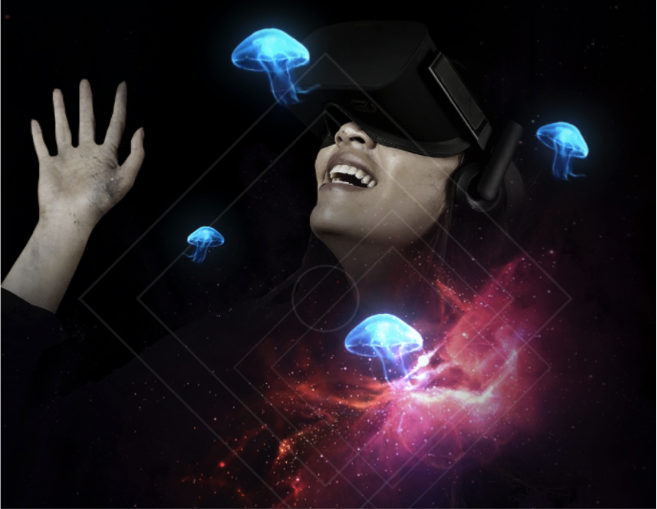
Imagine a multiplayer arcade in Hangzhou, Japan, Singapore and South Korea powered on the cloud, and best of all, available in VR! This is the innovative new concept that Malaysian gaming startup DJM pitched at this year’s Create Alibaba Cloud Startup Competition (CACSC) held in Hangzhou.
We sat down with Founding Partner Kee Saik Meng during the 2016 Alibaba Cloud Computing Conference to learn more about DJM’s innovative new technology and how they are leading the industry in slashing latency and creating new player hardware for VR shooter games.
DJM is a VR (virtual reality) lab based in Malaysia, and we have been doing R&D into VR for two years already. The product we have now is quite unique. It is a free roaming wireless multiplayer VR game.
So if you have tried VR before, you will know most VR is wired, or if its wireless you won’t be able to move too far away from your initial starting point. But with our solution we offer a wireless VR integrated solution in a 10-by-10 meter environment. You can imagine a basketball court as the minimum size, but we can also do large spaces as well with 4-6 players. Inside the environment we can capture full body motion as the players move around in a virtual world to shoot their friends or monsters in the game. Inside the environment you can jump, you can squat, you can even military crawl style on the floor, except you can’t commando roll just yet!
The first application that we are building is a first-person sci-fi shooter game that you can play for 20 minutes. The other thing we have been conducting R&D on is optimizing the wireless latency. This means you can play for 20 minutes with no dizziness at all. Normally though, because most VR games have high latency, if you play for a long time you are subject to motion sickness and dizziness.
We have a prototype now in our office and we’ve been getting lots of requests from theme parks, shopping centers and arcades looking into our VR solution. Theme parks and shopping centers are always looking for new content to bring in more traffic and VR is the next big thing. There are actually very few people who are offering VR gaming solutions for public spaces and we are only one of three companies in the world currently operating in this space.
In terms of offline space we are looking at a 10-by-10 meter environment to start an arcade but of course we can set up multiple rooms of 10-by-10 and a flagship store. For our flagship store model we include extra rooms, including a player gallery and a clothing store to sell merchandise.
In terms of infrastructure, right now the VR arcade can be stand-alone with its own internal server. But we have been talking to Alibaba Cloud, and that was our proposition that won us the contest in Singapore. Our pitch was: Imagine an arcade in Hangzhou, Japan, Singapore and Korea, and by putting it all on the cloud you play multiplayer live across all those regions.
There is then a big opportunity to build a fan base out of this, and we know Alibaba has been investing heavily in E-Sports as well. We are actually currently working with Alibaba Cloud in cloud technology and have already started some initial projects. We next want to take it all the way to a full multi-player system.
The first concept store we will probably build in Malaysia, Singapore or another city in Southeast Asia. But we can build it anywhere really. If a Japanese investor – and Japan has so many theme parks and arcades - comes along and is impressed with it then we can build it in Japan, or say China.
The first thing is the people running the operations in the Asia market. This has been the biggest challenge so far. We need to find really good people, especially on the tech side, and then build a tech team that really understands where we want to go, and who have the capabilities to build those products.
Then of course we need the cloud infrastructure where we can coordinate all the gaming content integration, the player integration and fan base management.
The final thing is to set up a first concept arcade and then expand from there. Once we have a first concept arcade we then have proof of commercialization. We will also know how people respond to the game and how much people are willing to pay for it. Next we can build arcades in any country in the world and we have a franchise model for that as well.
Cloud technology is really important, because this is where we can build a fan base, by getting people to play with each other in a multiplayer setting. From there we can also introduce levels, tournaments and leaderboards to increase the friendly gaming between the players and countries and host this on the cloud.
Gaming on the cloud of course is one thing, but what we want to do is multiplayer VR gaming. Latency is therefore very important, and if your latency is not good, players will get dizzy and can’t enjoy the game. It will be really groundbreaking if and once we can achieve this new model of gaming
There are also other opportunities outside of gaming. Naturally the first application we are looking at is a game within an arcade scenario. But the next level will be to use the technology in military training and athletic training because we will have the technology to capture full body movements, hand coordination and speed, and then analyze it.
We also hope to patent some of the hardware that we our building ourselves once it becomes available. Currently, we are doing R&D on a full body vest with haptic feedback. In terms of wireless latency we are also looking at an algorithm to minimize that too.
But that will all come in the next phase. So right now we are in…phase zero…because we haven’t actually put the arcade out into the market yet. But once we have a minimal level fan base, we would like to integrate data mining regarding player capabilities, and encourage repeat players who can analyze how they are playing, including how fast are they moving, how accurate they are shooting and their playing strategy in the game.
We have also found that for a VR game it is best to minimize player time to 20 minutes and minimize latency down to 0.8. This is because players are moving quite fast in the environment.
I think no matter what startup, you have to first be clear on what you want to build and how you will roll out your products. There are so many challenges that a startup has to go through, even after you first product launch. The challenge of scaling up, and getting investors through the various rounds, and each investor is looking for a different milestone and criteria. And of course be tough, be persistent and don’t give up.
Then you need decide whether you want to put your business on the cloud or not. I think not all businesses need to put their operations on the cloud. But I foresee that for businesses that need to scale, and especially those that want to scale globally in a fast manner, they should look at putting it on the cloud. https://www.youtube.com/watch?v=-YR1v48v98Q
Kafka vs. Apache RocketMQ™- Multiple Topic Stress Test Results

2,599 posts | 764 followers
FollowAlibaba Cloud Community - February 15, 2022
Alibaba Cloud Community - May 16, 2022
Alibaba Clouder - December 23, 2016
Alibaba Cloud Community - August 28, 2024
Iain Ferguson - December 22, 2021
JJ Lim - December 6, 2021

2,599 posts | 764 followers
Follow Gaming Solution
Gaming Solution
When demand is unpredictable or testing is required for new features, the ability to spin capacity up or down is made easy with Alibaba Cloud gaming solutions.
Learn More Cloud Database Solutions for Gaming
Cloud Database Solutions for Gaming
Alibaba Cloud’s world-leading database technologies solve all data problems for game companies, bringing you matured and customized architectures with high scalability, reliability, and agility.
Learn More Metaverse Solution
Metaverse Solution
Metaverse is the next generation of the Internet.
Learn More FinTech on Cloud Solution
FinTech on Cloud Solution
This solution enables FinTech companies to run workloads on the cloud, bringing greater customer satisfaction with lower latency and higher scalability.
Learn MoreMore Posts by Alibaba Clouder